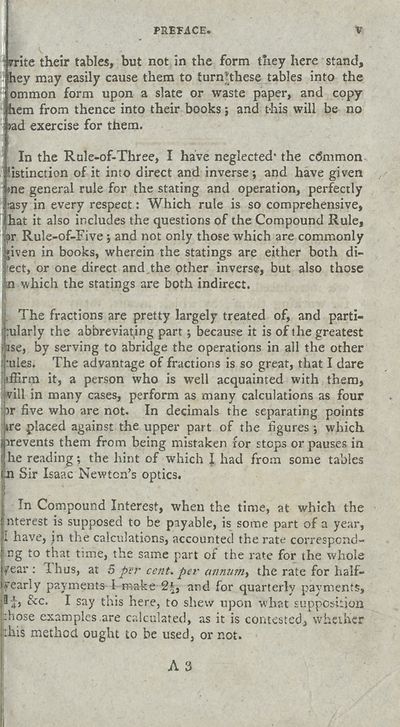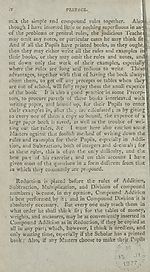Download files
Complete book:
Individual page:
Thumbnail gallery: Grid view | List view

PREFACE.
: rrite their tables, but not in the form they here stand,
hey may easily cause them to turn^these tables into the
ommon form upon a slate or waste paper, and copy
; hem from thence into their books; and this will be no
>ad exercise for them.
In the Rule-of-Three, I have neglected* the cdmmon
(istinction of it into direct and inverse; and have given
>ne general rule for the stating and operation, perfectly
:asy in every respect: Which rule is so comprehensive,
hat it also includes the questions of the Compound Rule,
ipr Rule-of-Five; and not only those which are commonly
[iven in books, wherein the statings are either both di¬
rect, or one direct and. the pther inverse, but also those
n which the statings are both indirect.
The fractions are pretty largely treated of, and parti-
mlarly the abbreviating part ; because it is of the greatest
ase, by serving to abridge the operations in all the other
•ules. The advantage of fractions is so great, that I dare
tffirm it, a person who is well acquainted with them,
vill in many cases, perform as many calculations as four
ar five who are not. In decimals the separating points
ire placed against the upper part of the figures ; which
arevents them from being mistaken for steps or pauses in
he reading; the hint of which $ had from some tables
n Sir Isaac Newton’s optics.
In Compound Interest, when the time, at which the
nterest is supposed to be payable, is some part of a year,
[ have, jn the calculations, accounted the rate correspond-
ng to that time, the same part of the rate for the whole
pear : Thus, at 5 ptr cent, per annum, the rate for half-
yearly payments I make 2*, and for quarterly payments,
I say this here, to shew upon what supposition
those examples are calculated, as it is contested, whether
this method ought to be used, or not.
A 3
: rrite their tables, but not in the form they here stand,
hey may easily cause them to turn^these tables into the
ommon form upon a slate or waste paper, and copy
; hem from thence into their books; and this will be no
>ad exercise for them.
In the Rule-of-Three, I have neglected* the cdmmon
(istinction of it into direct and inverse; and have given
>ne general rule for the stating and operation, perfectly
:asy in every respect: Which rule is so comprehensive,
hat it also includes the questions of the Compound Rule,
ipr Rule-of-Five; and not only those which are commonly
[iven in books, wherein the statings are either both di¬
rect, or one direct and. the pther inverse, but also those
n which the statings are both indirect.
The fractions are pretty largely treated of, and parti-
mlarly the abbreviating part ; because it is of the greatest
ase, by serving to abridge the operations in all the other
•ules. The advantage of fractions is so great, that I dare
tffirm it, a person who is well acquainted with them,
vill in many cases, perform as many calculations as four
ar five who are not. In decimals the separating points
ire placed against the upper part of the figures ; which
arevents them from being mistaken for steps or pauses in
he reading; the hint of which $ had from some tables
n Sir Isaac Newton’s optics.
In Compound Interest, when the time, at which the
nterest is supposed to be payable, is some part of a year,
[ have, jn the calculations, accounted the rate correspond-
ng to that time, the same part of the rate for the whole
pear : Thus, at 5 ptr cent, per annum, the rate for half-
yearly payments I make 2*, and for quarterly payments,
I say this here, to shew upon what supposition
those examples are calculated, as it is contested, whether
this method ought to be used, or not.
A 3
Set display mode to:
![]() Universal Viewer |
Universal Viewer | ![]() Mirador |
Large image | Transcription
Mirador |
Large image | Transcription
| Antiquarian books of Scotland > Education > Complete treatise on practical arithmetic and book-keeping > (11) |
|---|
| Permanent URL | https://digital.nls.uk/114433702 |
|---|
| Description | Thousands of printed books from the Antiquarian Books of Scotland collection which dates from 1641 to the 1980s. The collection consists of 14,800 books which were published in Scotland or have a Scottish connection, e.g. through the author, printer or owner. Subjects covered include sport, education, diseases, adventure, occupations, Jacobites, politics and religion. Among the 29 languages represented are English, Gaelic, Italian, French, Russian and Swedish. |
|---|

